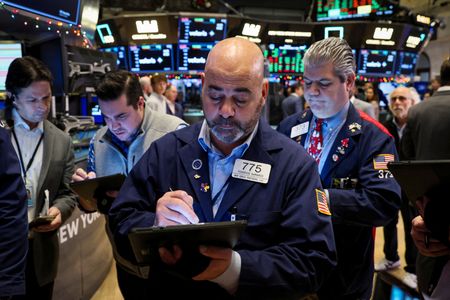By Jamie McGeever
ORLANDO, Fla. (Reuters) -The comfort blanket of juicy illiquidity premiums that private debt investors enjoy in return for locking in to an opaque and illiquid market is being yanked away, as the risk of recession and rising default rates grows.
The turning economic cycle also exposes another inherent risk that is hidden from sight in the “Goldilocks” world of low inflation, low interest rates and booming asset markets: price discovery.
When times are good, private debt investors do not need to sell, do not need the liquidity, and are comfortable with only periodic asset revaluations because the direction of travel is invariably upward.
Liquidity and pricing risk is naturally greater in private markets than traditional public markets like the S&P 500 or U.S. government bonds, as the recent furor with Blackstone and its $69 billion real estate income trust (REIT) highlighted.
Within private markets, however, price discovery in debt is usually more regular and transparent. Analysts at UBS say private debt is typically valued on a monthly basis, compared with every quarter in private equity and up to once a year in REITs.
But according to alternative asset data provider Preqin, private debt managers have so far done “comparatively little” to mark down portfolio valuations to reflect volatile market conditions, “partially out of hope that risk assets can rebound.”
Hope is not a strategy though, and if risk assets are cheaper over the coming year, private debt valuations will have to be marked down accordingly.
In its 2023 outlook released this week, Preqin forecast continued inflows in the coming years, adding that private credit remains an attractive long-term investment “for those able to tolerate its illiquidity.”
SLIGHT RETURN
Private debt performed well this year, certainly relative to publicly traded bonds like U.S. Treasuries, which had one of their worst years on record as the Fed embarked on its most aggressive rate-hiking campaign in 40 years.
Research by analysts at UBS shows that private credit returns outstripped public debt returns in every one of the last eight periods where the 10-year U.S. Treasury yield rose by 75 bps or more.
The most recent period observed, from Q4 last year through Q2 this year, showed the lowest nominal returns for private debt of only 4.7%. But set against a historic 10.3% plunge in public markets, they outperformed hugely.
All well and good, but the fact that the most recent broad sweep of returns data is for a period that ended almost six months ago underlines the opaque nature of the market and not insubstantial price discovery risks.
In a survey published this week, Preqin showed that nearly three-quarters of the institutional investors polled think private debt is still either undervalued or fairly valued. This suggests a willingness to keep investing.
Diversification remains the No. 1 reason for doing so, similar to last year. But a “reliable income stream” has shot up to second place, displacing “high risk-adjusted returns,” which fell to fourth – a sign of caution trumping adventure.
EXIT DIFFICULTIES
In a high-inflation and rising interest rate environment, private debt offers relatively steady income because most products are floating rate. But policy rates and yields at or close to their peaks changes this calculation.
No one knows for sure how inflation will play out next year, but it looks likely that it has topped out, and so the bulk of the Fed’s policy tightening is behind us.
Therefore, it is unlikely that publicly traded debt will perform so badly next year, and from a risk-reward perspective, the case for buying Treasuries is probably stronger now than the case for buying equities.
Rising demand for Treasuries from the ashes of the 2022 bonfire would bring implied bond market volatility down from this year’s historic highs and diminish private debt markets’ allure as a beacon of relative stability.
This suggests less potential for private credit outperformance.
Equally, persistently high borrowing costs and Treasury yields puts a tighter squeeze on the economy, which would spell trouble for private debt.
“If higher rates persist and we experience a more prolonged recession, defaults could rise, cumulative losses could accrue, and private debt investors might face a less liquid exit environment,” UBS analysts warned in a report published on Nov. 29.
They expect U.S. high-yield corporate defaults to rise to mid-single-digit rates over the next 12 months from close to 1% currently.
(The opinions expressed here are those of the author, a columnist for Reuters.)
(By Jamie McGeever in Orlando, Fla.Editing by Matthew Lewis)

